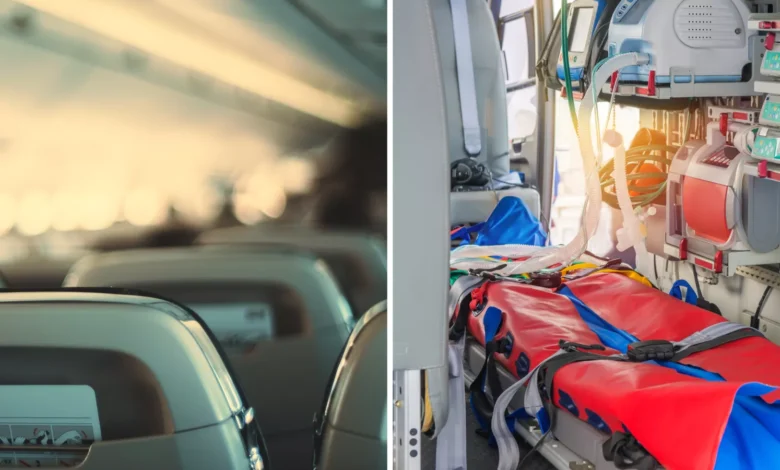Why does a doctor refuse mid air emergency


The Importance of Medical Emergencies on Flights
Flying is a standard mode of transportation that allows us to travel across the world in hours. With the increasing number of people flying, medical emergencies will inevitably occur on flights. These emergencies range from minor incidents, such as motion sickness, to more severe situations, like heart attacks or strokes.
Medical emergencies on flights are not uncommon and can happen for various reasons. One of the main reasons is the change in air pressure and oxygen levels during a flight. This can put stress on the body, especially for individuals with pre-existing health conditions such as heart or lung diseases. Additionally, long periods of sitting and limited movement can also increase the risk of developing blood clots, which can lead to severe complications if left untreated.
The importance of being prepared for medical emergencies on flights cannot be overstated. As much as we hope for smooth and uneventful flights, flight attendants and other crew members must be equipped and trained to handle any potential medical situations that may arise.
In cases where a passenger experiences a medical emergency, prompt and appropriate action must be taken to ensure their Safety and well-being. This responsibility often falls upon the flight attendants trained in basic first aid techniques and have access to onboard medical kits containing essential medications and equipment.
However, there are limitations to what flight attendants can do in emergencies due to their lack of proper training or resources. In some cases, they may need assistance from healthcare professionals who are passengers onboard.
This raises the question – should doctors be obligated or expected to provide medical assistance during mid-air emergencies? While many doctors may feel morally compelled to help in such situations, several factors make them hesitant or even refuse to intervene.
One major factor is liability concerns. Despite Good Samaritan laws protecting healthcare professionals from legal action when providing emergency care outside their workplace, there is still a fear of potential lawsuits in the event of an unfavorable outcome.
Furthermore, doctors may need access to the proper equipment and resources to provide adequate care. This can be particularly challenging when dealing with serious medical emergencies that require advanced medical interventions.
Airlines need to prioritize the preparedness and training of their crew members in handling medical emergencies on flights. At the same time, healthcare professionals must understand their limitations and consider various factors before deciding whether or not they should assist during mid-air emergencies.
Definition of Mid-Air Emergency
A mid-air emergency is a situation that occurs during a flight where the Safety and well-being of the passengers, crew, or aircraft are compromised. This can range from minor issues such as turbulence or a medical emergency to severe incidents like engine failure or cabin decompression.
The Federal Aviation Administration (FAA) defines an in-flight emergency as “an unexpected event that requires immediate action to protect the safety of passengers, crew, or the aircraft.” This definition encompasses all kinds of emergencies that can occur while in the air.
One common type of mid-air emergency is a medical emergency. This can range from a passenger experiencing discomfort due to dehydration or allergies to more severe conditions such as heart attacks or strokes. In these situations, the pilot must make quick and informed decisions about diverting the flight for an emergency landing or contacting medical personnel for assistance.
Another type of mid-air emergency is mechanical failure. Despite strict maintenance protocols and regular inspections, there are instances when something malfunctions onboard an aircraft. This could be anything from an electrical issue to complete engine failure. In these cases, pilots rely on their training and experience to troubleshoot and handle the situation safely while also communicating with Air Traffic Control (ATC) for assistance.
Weather-related emergencies are also not uncommon during flights. Turbulence caused by storms or other weather patterns can create sudden drops in altitude, which may cause panic among passengers and crew members. Pilots must navigate severe weather conditions and constantly communicate with ATC for updated weather reports and alternate routes if necessary.
In rare cases, mid-air emergencies may involve security threats such as unruly passengers or hijackings. These situations require swift action from pilots who must follow specific protocols while ensuring everyone onboard’s Safety.
A mid-air emergency is any unforeseen event during a flight that poses a potential danger to passengers, crew, or the aircraft itself. Pilots are responsible for handling these situations calmly and efficiently, making prompt decisions that prioritize the Safety of all those onboard.
Case Study: A Doctor Refusing to Help During a Mid-Air Emergency
In April 2017, a passenger on board United Airlines Flight 3411 suffered a medical emergency while the plane was in mid-air. The passenger, Dr. David Dao, was traveling from Chicago to Louisville when he experienced difficulty breathing and needed immediate medical assistance.
The flight crew called asking if any doctors could help with the emergency. Two doctors responded and offered assistance, but surprisingly, one refused to provide aid.
This doctor’s refusal sparked outrage and raised questions about why someone would refuse to help during an emergency. It also sheds light on the ethical responsibilities of medical professionals in such situations.
According to multiple reports, this doctor had paid for his first-class seat and wanted to avoid leaving his spot or inconveniencing himself by treating the patient in economy class. He even stated that he had patients waiting for him at his destination and did not want to delay his arrival.
While these may seem valid, they go against the Hippocratic Oath that all doctors take upon entering the medical profession. This oath states that physicians should “use treatment to help the sick according to [their] ability and judgment” without discrimination or prioritizing personal comfort over saving lives.
The doctor’s actions drew widespread criticism from fellow passengers and medical professionals alike. One passenger reportedly yelled at him, saying, “You’re a heartless man!” Other doctors condemned his decision as it goes against their ethical code of conduct.
Furthermore, refusing to offer aid during an in-flight emergency is also considered illegal under federal law in the United States. The Aviation Medical Assistance Act requires any physician on board a commercial aircraft with knowledge of an onboard medical emergency to assist if requested by the flight crew.
In this case study, it is clear that this doctor failed to fulfill his ethical obligations and disregarded the law. It also highlights the importance of preparing for medical emergencies, especially traveling.
This case study reminds all medical professionals that their duty is to save lives and provide care when needed, regardless of personal comfort or convenience. Neglecting this responsibility not only goes against their oath but also violates laws that protect the safety and well-being of passengers.
Possible Reasons for the Doctor’s Refusal
There can be various reasons for a doctor to refuse to attend to a mid-air emergency. Some of the possible reasons are:
1. Lack of Necessary Equipment: In many cases, doctors may need access to essential medical equipment or supplies on board an airplane. This can make it difficult for them to provide proper emergency treatment and care.
2. Legal Concerns: Doctors are bound by ethical and legal guidelines that require them to provide medical assistance only within their expertise and competence. If the emergency is outside their scope of practice, they may hesitate to intervene due to legal concerns.
3. Unfamiliar Environment: An airplane’s cabin pressure and altitude changes can affect a person’s physical condition differently than on the ground. This unfamiliar environment can make it challenging for doctors who are used to treating patients in controlled settings.
4. Limited Resources: In a severe medical emergency, immediate evacuation may be required, often not feasible mid-flight. Doctors may only treat patients with access to specialist care or advanced medical facilities if needed.
5. Personal Health Concerns: Like any other passenger, doctors risk developing health problems during flights, such as motion sickness or jet lag. These personal health concerns can prevent them from providing prompt assistance during emergencies.
6. Fear of Legal Liability: Despite good Samaritan laws that protect healthcare professionals from legal liability when rendering aid during emergencies, some doctors may still fear potential lawsuits if something goes wrong with their treatment efforts.
7. Time Constraints: Physicians often have busy schedules and may need more time between connecting flights for extended patient care during flight diversions or delays.
8. Lack of Training/Experience: Not all physicians have received specialized training in handling in-flight emergencies or managing specific conditions that could occur during air travel, such as deep vein thrombosis or hypoxia.
While we expect our doctors to be able to handle any medical emergency, it is essential to understand that there may be valid reasons for their refusal in mid-air situations. It is always advisable to clearly understand your doctor’s capabilities and limitations before traveling, especially if you have pre-existing medical conditions that may require attention during the flight. In an emergency, communication with the airline staff and other passengers can also help find alternative solutions until proper medical assistance is available upon landing.
Legal Concerns:
In a mid-air emergency, one may wonder what legal implications arise for the doctor and the airline. The situation can become even more complex if the doctor on board refuses to offer medical assistance. While doctors are often hailed as heroes in such situations, several legal concerns must be considered.
Firstly, it is essential to note that doctors are not obligated to provide medical assistance in non-emergency situations. This means that if a passenger falls ill during a flight but is not deemed an emergency, the doctor has every right to refuse treatment without facing legal consequences. This is because doctors are only bound by their oath to provide care during emergencies or when explicitly hired for their medical services.
However, in a genuine mid-air emergency requiring immediate medical attention, refusing to provide aid can bring about serious legal ramifications for the doctor and the airline. In most countries, including the United States and Canada, Good Samaritan laws protect individuals who offer voluntary aid during emergencies from any liability. These laws also extend to licensed healthcare professionals like doctors.
Yet, while these laws do exist, they may only sometimes apply depending on various factors, such as the location of the incident and jurisdictional differences between countries. Additionally, there may be specific regulations set by individual airlines regarding providing medical assistance during flights. Therefore, doctors must familiarize themselves with these laws and regulations before traveling.
Another legal concern arises when considering potential malpractice lawsuits against doctors who have provided medical aid during emergencies on a flight. Despite being protected under Good Samaritan laws, some patients or their families may still choose to file lawsuits against doctors for negligence or substandard care provided during an emergency. While these lawsuits may be rare due to the high burden of proof required by plaintiffs in such cases, they must be partially ruled out.
While doctors have a moral and ethical obligation to provide medical assistance in mid-air emergencies, they are not legally obligated to do so except in certain circumstances. Doctors need to be aware of their rights, responsibilities, and potential legal implications when faced with such situations while on a flight.
– Personal Safety
Personal Safety is a crucial aspect of any emergency, especially in mid-air. It is essential to adhere to safety protocols and guidelines to ensure the well-being of both passengers and crew members. This section will discuss some key factors contributing to personal Safety during a mid-air emergency and why they are essential.
The first and foremost aspect of personal Safety during an emergency is remaining calm. Panic can cause individuals to act irrationally and make hasty decisions that can put themselves and others at risk. Therefore, passengers need to listen carefully to the instructions given by the flight crew and follow them calmly.
Always wearing seatbelts is another crucial factor in ensuring personal Safety during an emergency. Seatbelts are designed to keep passengers securely in their seats during turbulence or unexpected events such as sudden drops in altitude. Not wearing a seatbelt can lead to serious injuries or even fatalities if the aircraft encounters severe turbulence or makes abrupt maneuvers.
It is also essential for passengers to be aware of their surroundings at all times. This includes knowing where the nearest exits are located, how many rows they need to move forward or backward to reach them, and how they operate. Being familiar with these details can save valuable time and help prevent injuries in an evacuation.
In addition, following the instructions given by the flight crew regarding protective measures such as oxygen masks or life jackets is crucial for personal Safety in case of emergencies like loss of cabin pressure or ditching over water. These devices are designed to provide necessary support until further assistance arrives.
Furthermore, avoiding dangerous objects such as fire extinguishers or sharp items can contribute significantly to personal safety during an emergency. It is essential not only for one’s well-being but also for those around them.
Passengers mustn’t consume alcoholic beverages during an emergency as it impairs judgment and reflexes, hindering their ability to follow safety protocols.
Personal Safety is of utmost importance during mid-air emergencies. Staying calm, wearing seatbelts, being aware of surroundings, following instructions, and avoiding dangerous items are vital factors that can help ensure the well-being of all individuals on board. By adhering to these guidelines and cooperating with the flight crew, we can significantly minimize potential risks and provide a safe outcome in emergencies.
you may also read digitalfastnews.





